Progressive Frequency-Guided Depth Model with Adaptive Preprocessing for Casting Defect Detection
Abstract
:1. Introduction
- A highly effective casting defect detection method based on DR images, providing a strong baseline for non-destructive testing of industrial castings and greatly alleviating the problem of low detection accuracy for weak defects.
- We carefully establish four specialized components: adaptive preprocessing, subtle clue mining based on frequency-domain attention, feature refinement based on progressive learning, and a deep regression supervision mechanism for refinement. These modules are interrelated, and work together to improve the overall performance of the model.
- We have carried out a large number of experiments, including ablation studies, comparisons with other methods, and image parameter analysis to establish and demonstrate the effectiveness of the proposed method.
2. Related Work
2.1. Automatic Defect Detection Methods
2.2. Attention Mechanisms in Casting Defect Detection
3. Methodology
3.1. System Overview
3.2. Adaptive Preprocessing
3.3. Subtle Clue Mining Based on Frequency Domain Attention
3.4. Feature Refinement Based on Progressive Learning
3.5. Refined Deep Regression Supervision
4. Experiment and Discussion
4.1. Experimental Setup
4.1.1. Dataset
4.1.2. Parameter Settings
4.1.3. Evaluation Metrics
4.2. Ablation Experiments
4.3. Comparison with Other Casting Defect Detection Methods
4.4. Model Robustness Analysis
4.5. Structural Analysis
4.6. Limitation Discussion
5. Conclusions
Author Contributions
Funding
Data Availability Statement
Conflicts of Interest
References
- Ding, Z.; Zhao, J.; Misra, R.D.K.; Guo, F.; Xie, Z.; Wang, X.; Li, X.; Wang, J.; Shang, C. Deep Learning-Based Understanding of Defects in Continuous Casting Product. Metals 2023, 13, 1809. [Google Scholar] [CrossRef]
- Jung, B.; You, H.; Lee, S. Anomaly Candidate Extraction and Detection for automatic quality inspection of metal casting products using high-resolution images. J. Manuf. Syst. 2023, 67, 229–241. [Google Scholar] [CrossRef]
- Liu, P.; Ding, Z.; Zhang, W.; Ren, Z.; Yang, X. Using Ground-Penetrating Radar and Deep Learning to Rapidly Detect Voids and Rebar Defects in Linings. Sustainability 2023, 15, 11855. [Google Scholar] [CrossRef]
- Gupta, R.; Anand, V.; Gupta, S.; Koundal, D. Deep learning model for defect analysis in industry using casting images. Expert Syst. Appl. 2023, 232, 120758. [Google Scholar] [CrossRef]
- Liu, F.; Zhu, X.; Feng, P.; Zeng, L. Anomaly Detection via Progressive Reconstruction and Hierarchical Feature Fusion. Sensors 2023, 23, 8750. [Google Scholar] [CrossRef] [PubMed]
- Staude, A.; Bartscher, M.; Ehrig, K.; Goebbels, J.; Koch, M.; Neuschaefer-Rube, U.; Nötel, J. Quantification of the capability of micro-CT to detect defects in castings using a new test piece and a voxel-based comparison method. NDT E Int. 2011, 44, 531–536. [Google Scholar] [CrossRef]
- du Plessis, A.; Rossouw, P. X-ray computed tomography of a titanium aerospace investment casting. Case Stud. Nondestruct. Test. Eval. 2015, 3, 21–26. [Google Scholar] [CrossRef]
- Warnett, J.M.; Titarenko, V.; Kiraci, E.; Attridge, A.; Lionheart, W.R.B.; Withers, P.J.; Williams, M.A. Towards in-process X-ray CT for dimensional metrology. Meas. Sci. Technol. 2016, 27, 035401. [Google Scholar] [CrossRef]
- Villarraga-Gómez, H.; Lee, C.; Smith, S.T. Dimensional metrology with X-ray CT: A comparison with CMM measurements on internal features and compliant structures. Precis. Eng. 2018, 51, 291–307. [Google Scholar] [CrossRef]
- Carvalho, R.; Morgado, A.C.; Gonçalves, J.; Kumar, A.; Rolo, A.G.e.S.; Carreira, R.; Soares, F. Computer-Aided Visual Inspection of Glass-Coated Tableware Ceramics for Multi-Class Defect Detection. Appl. Sci. 2023, 13, 11708. [Google Scholar] [CrossRef]
- Wang, L.; Zhang, H.; Liu, J.; Qu, F.; Zuo, F. Defect Size Quantification for Pipeline Magnetic Flux Leakage Detection System via Multilevel Knowledge-Guided Neural Network. IEEE Trans. Ind. Electron. 2023, 70, 9550–9560. [Google Scholar] [CrossRef]
- Li, H.; Wang, X.; Liu, Y.; Liu, G.; Zhai, Z.; Yan, X.; Wang, H.; Zhang, Y. A Novel Robotic-Vision-Based Defect Inspection System for Bracket Weldments in a Cloud–Edge Coordination Environment. Sustainability 2023, 15, 10783. [Google Scholar] [CrossRef]
- Zhang, K.; Wang, S.; Hu, Y.; Yang, H.; Guo, T.; Yi, X. Evaluation Method of Potato Storage External Defects Based on Improved U-Net. Agronomy 2023, 13, 2503. [Google Scholar] [CrossRef]
- Liu, J.; Liu, X.; Qu, F.; Zhang, H.; Zhang, L. A Defect Recognition Method for Low-Quality Weld Image Based on Consistent Multiscale Feature Mapping. IEEE Trans. Instrum. Meas. 2022, 71, 3512911. [Google Scholar] [CrossRef]
- Zuo, F.; Liu, J.; Wang, L.; Qu, F.; Fu, M. Active Learning-Based Complex Pipeline Weld Defect Detection with Lightweight Neural Network. In Proceedings of the 2022 IEEE 11th Data Driven Control and Learning Systems Conference (DDCLS), Chengdu, China, 3–5 August 2022; pp. 712–717. [Google Scholar] [CrossRef]
- Zhang, L.; Zhang, Y.; Dai, B.; Chen, B.; Li, Y. Welding defect detection based on local image enhancement. Image Process. IET 2019, 13, 2647–2658. [Google Scholar] [CrossRef]
- Wang, Y.; Guo, H. Weld Defect Detection of X-ray Images Based on Support Vector Machine. IETE Tech. Rev. 2014, 31, 137–142. [Google Scholar] [CrossRef]
- Boaretto, N.; Centeno, T.M. Automated detection of welding defects in pipelines from radiographic images DWDI. NDT E Int. 2017, 86, 7–13. [Google Scholar] [CrossRef]
- Shen, D.; Liu, X.; Shang, Y.; Tang, X. Deep Learning-Based Automatic Defect Detection Method for Sewer Pipelines. Sustainability 2023, 15, 9164. [Google Scholar] [CrossRef]
- Parlak, İ.E.; Emel, E. Deep learning-based detection of aluminum casting defects and their types. Eng. Appl. Artif. Intell. 2023, 118, 105636. [Google Scholar] [CrossRef]
- Zhou, F.; Chao, Y.; Wang, C.; Zhang, X.; Li, H.; Song, X. A small sample nonstandard gear surface defect detection method. Measurement 2023, 221, 113472. [Google Scholar] [CrossRef]
- Yu, H.; Li, X.; Song, K.; Shang, E.; Liu, H.; Yan, Y. Adaptive depth and receptive field selection network for defect semantic segmentation on castings X-rays. NDT E Int. 2020, 116, 102345. [Google Scholar] [CrossRef]
- Cheng, S.; Lu, J.; Yang, M.; Zhang, S.; Xu, Y.; Zhang, D.; Wang, H. Wheel hub defect detection based on the DS-Cascade RCNN. Measurement 2023, 206, 112208. [Google Scholar] [CrossRef]
- Liu, Y.; Xiao, H.; Xu, J.; Zhao, J. A Rail Surface Defect Detection Method Based on Pyramid Feature and Lightweight Convolutional Neural Network. IEEE Trans. Instrum. Meas. 2022, 71, 5009510. [Google Scholar] [CrossRef]
- Li, J.; Xu, F.; Zheng, X.; Liu, B.; Bai, T.; Tang, Q. Study on the Fracture Evolution Characteristics of Existing Defect Lining under Unsymmetrical Load. Sustainability 2023, 15, 9531. [Google Scholar] [CrossRef]
- Moskovchenko, A.; Svantner, M. Thermographic Data Processing and Feature Extraction Approaches for Machine Learning-Based Defect Detection. Eng. Proc. 2023, 51, 5. [Google Scholar] [CrossRef]
- Tang, J.; Liu, S.; Zhao, D.; Tang, L.; Zou, W.; Zheng, B. PCB-YOLO: An Improved Detection Algorithm of PCB Surface Defects Based on YOLOv5. Sustainability 2023, 15, 5963. [Google Scholar] [CrossRef]
- Jung, H.; Rhee, J. Application of YOLO and ResNet in Heat Staking Process Inspection. Sustainability 2022, 14, 15892. [Google Scholar] [CrossRef]
- Lu, J.; Lee, S.H. Real-Time Defect Detection Model in Industrial Environment Based on Lightweight Deep Learning Network. Electronics 2023, 12, 4388. [Google Scholar] [CrossRef]
- Wang, Y.; Hu, C.; Chen, K.; Yin, Z. Self-attention guided model for defect detection of aluminium alloy casting on X-ray image. Comput. Electr. Eng. 2020, 88, 106821. [Google Scholar] [CrossRef]
- Hu, C.; Wang, Y. An Efficient Convolutional Neural Network Model Based on Object-Level Attention Mechanism for Casting Defect Detection on Radiography Images. IEEE Trans. Ind. Electron. 2020, 67, 10922–10930. [Google Scholar] [CrossRef]
- Tang, Z.; Tian, E.; Wang, Y.; Wang, L.; Yang, T. Nondestructive Defect Detection in Castings by Using Spatial Attention Bilinear Convolutional Neural Network. IEEE Trans. Ind. Inform. 2021, 17, 82–89. [Google Scholar] [CrossRef]
- Jiang, L.; Wang, Y.; Tang, Z.; Miao, Y.; Chen, S. Casting defect detection in X-ray images using convolutional neural networks and attention-guided data augmentation. Measurement 2021, 170, 108736. [Google Scholar] [CrossRef]
- Ni, X.; Ma, Z.; Liu, J.; Shi, B.; Liu, H. Attention Network for Rail Surface Defect Detection via Consistency of Intersection-over-Union(IoU)-Guided Center-Point Estimation. IEEE Trans. Ind. Inform. 2022, 18, 1694–1705. [Google Scholar] [CrossRef]
- Siliang, M.; Yong, X. MPDIoU: A Loss for Efficient and Accurate Bounding Box Regression. arXiv 2023, arXiv:2307.07662. Available online: http://xxx.lanl.gov/abs/2307.07662 (accessed on 7 October 2023).
- Vilar, R.; Zapata, J.; Ruiz, R. An automatic system of classification of weld defects in radiographic images. NDT E Int. 2009, 42, 467–476. [Google Scholar] [CrossRef]
- Mery, D.; Riffo, V.; Zscherpel, U.; Mondragón, G.; Lillo, I.; Zuccar, I. GDXray: The Database of X-ray Images for Nondestructive Testing. J. Nondestruct. Eval. 2015, 34, 1–12. [Google Scholar] [CrossRef]
- Marmanis, D.; Datcu, M.; Esch, T.; Stilla, U. Deep Learning Earth Observation Classification Using ImageNet Pretrained Networks. IEEE Geosci. Remote Sens. Lett. 2016, 13, 105–109. [Google Scholar] [CrossRef]
- Xiao, M.; Yang, B.; Wang, S.; Zhang, Z.; He, Y. Fine coordinate attention for surface defect detection. Eng. Appl. Artif. Intell. 2023, 123, 106368. [Google Scholar] [CrossRef]

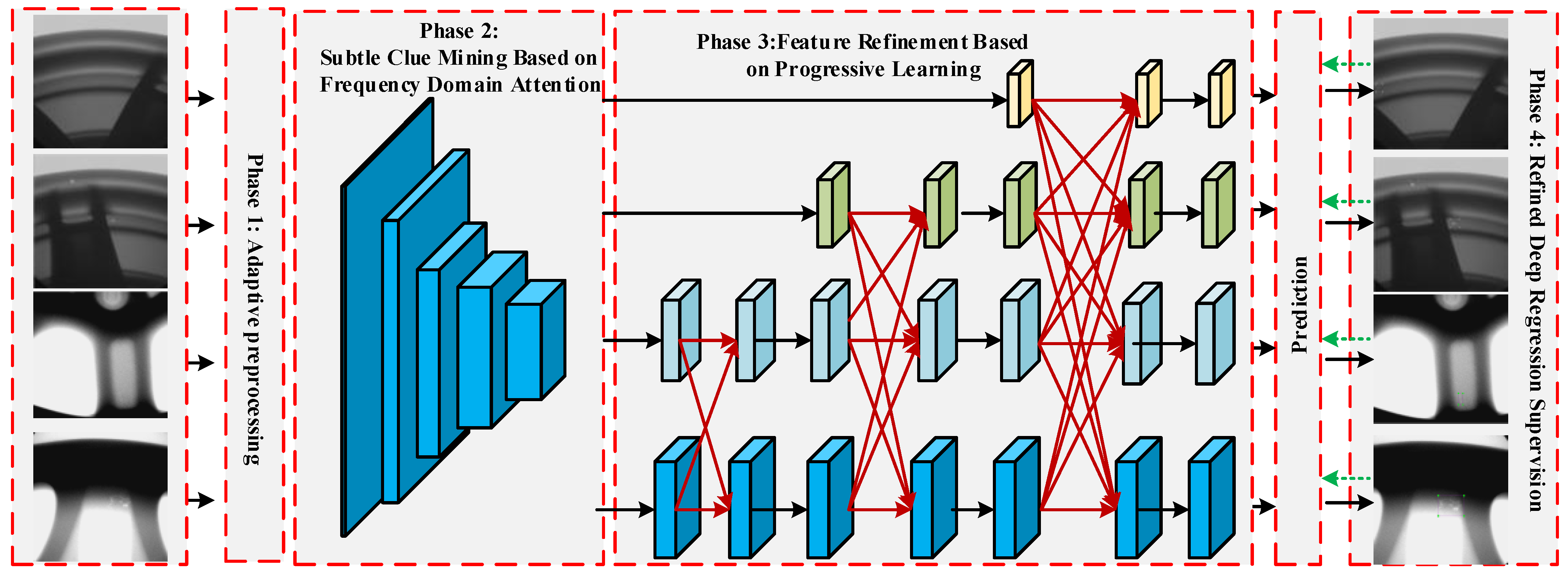


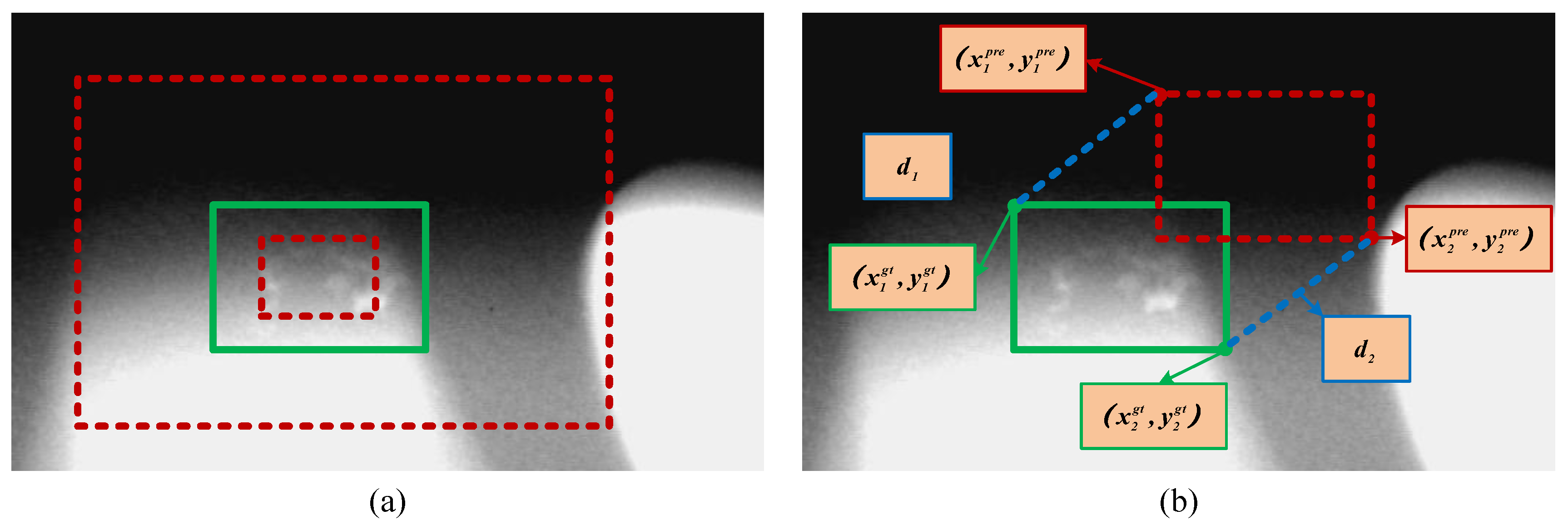


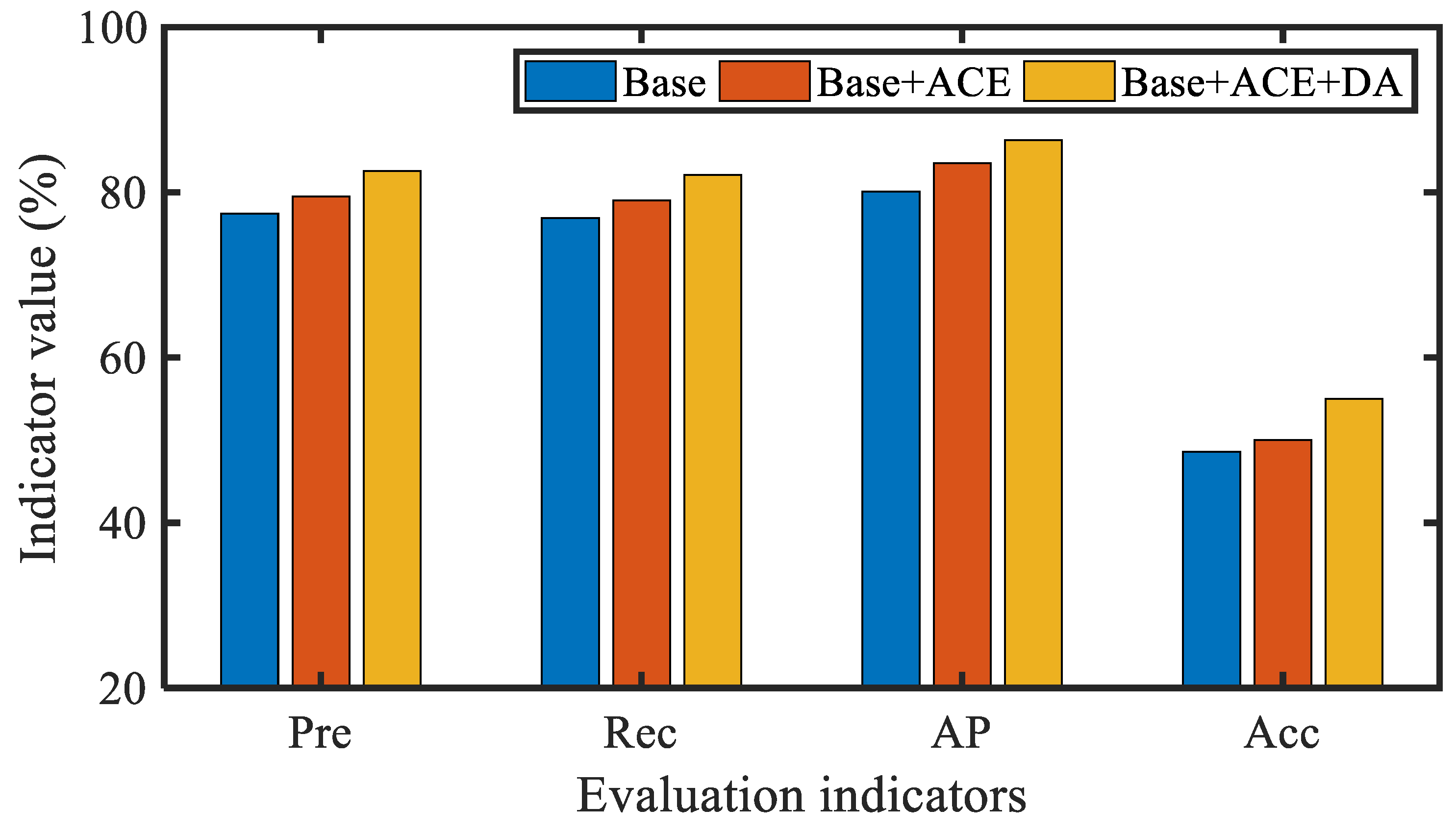
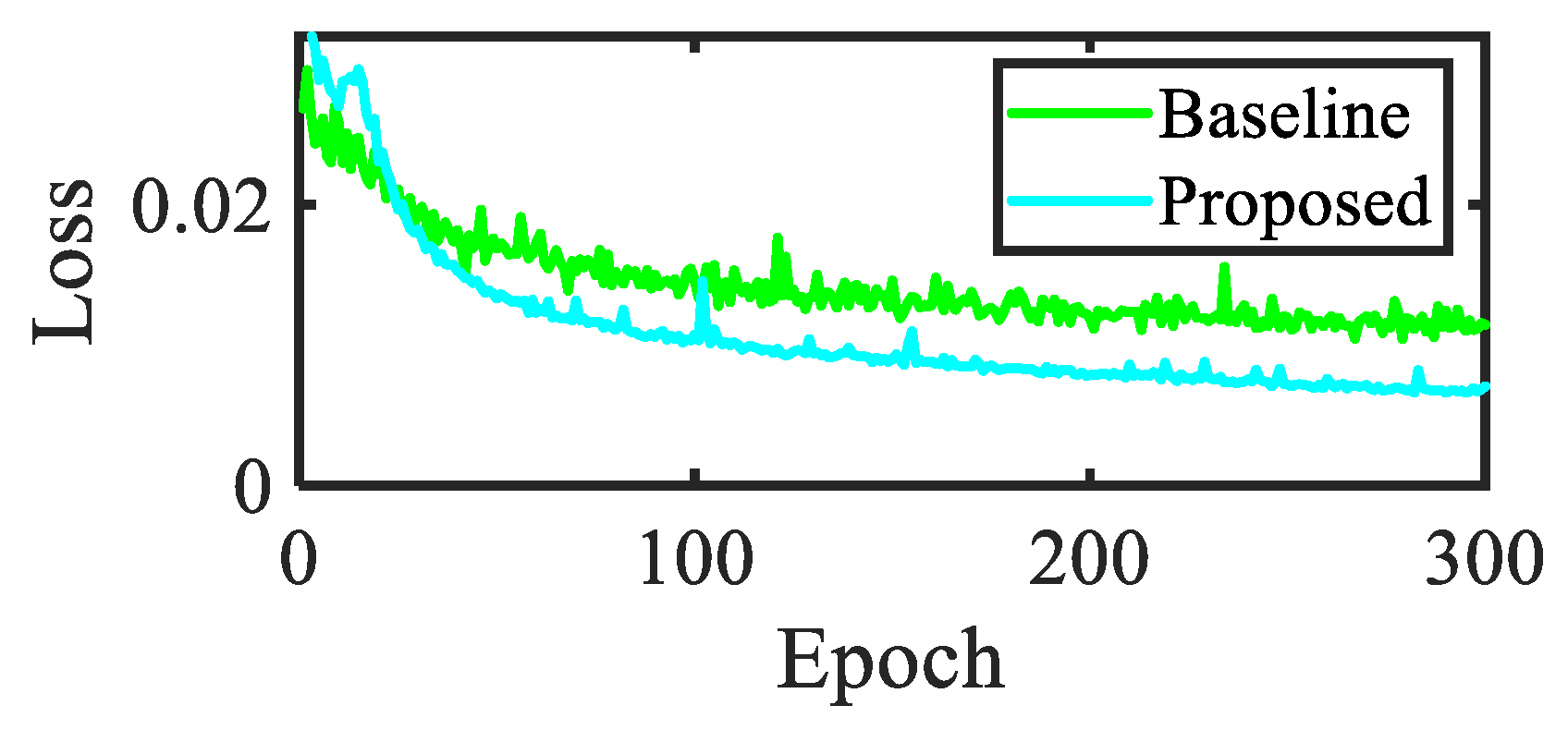
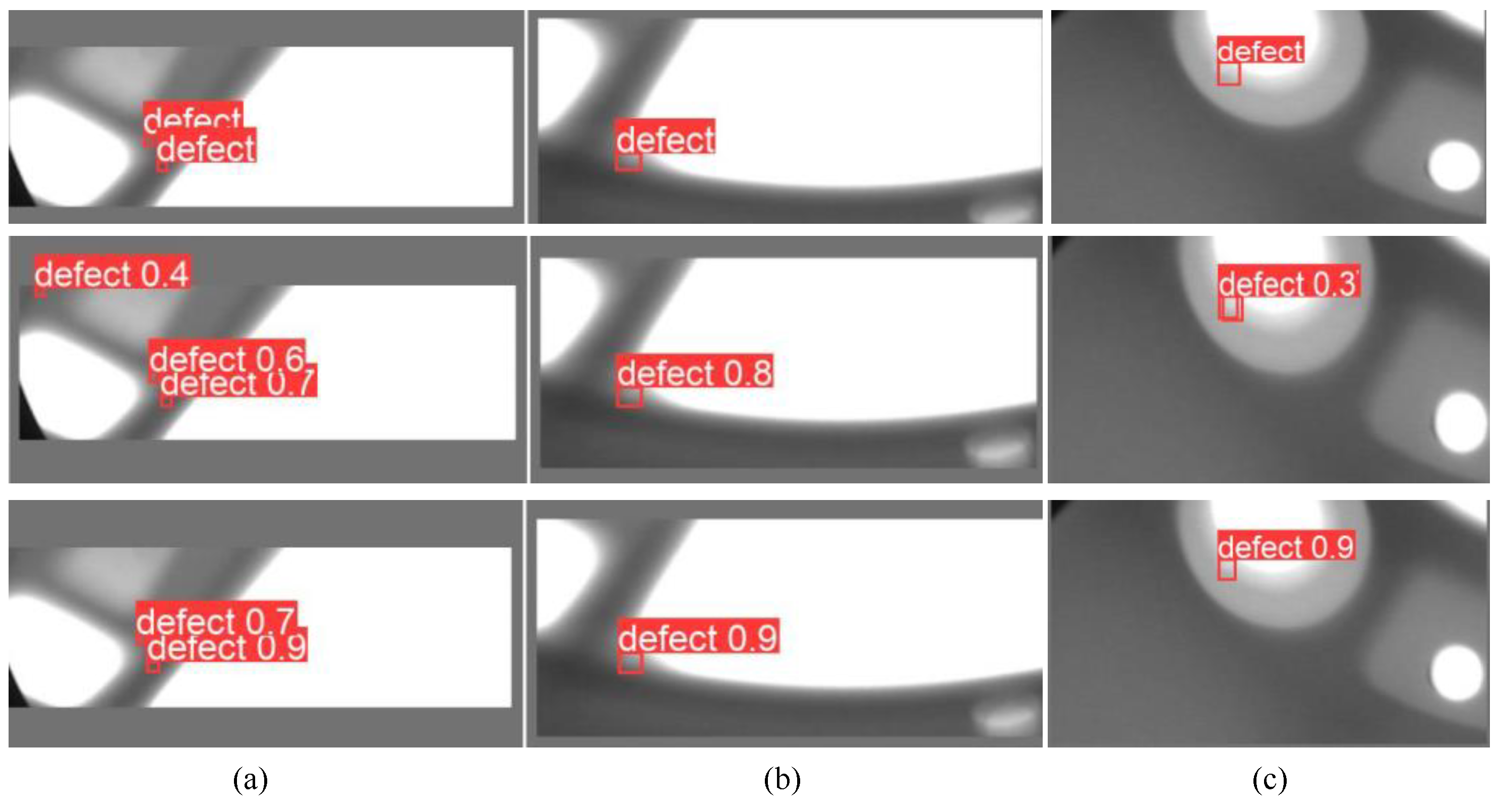


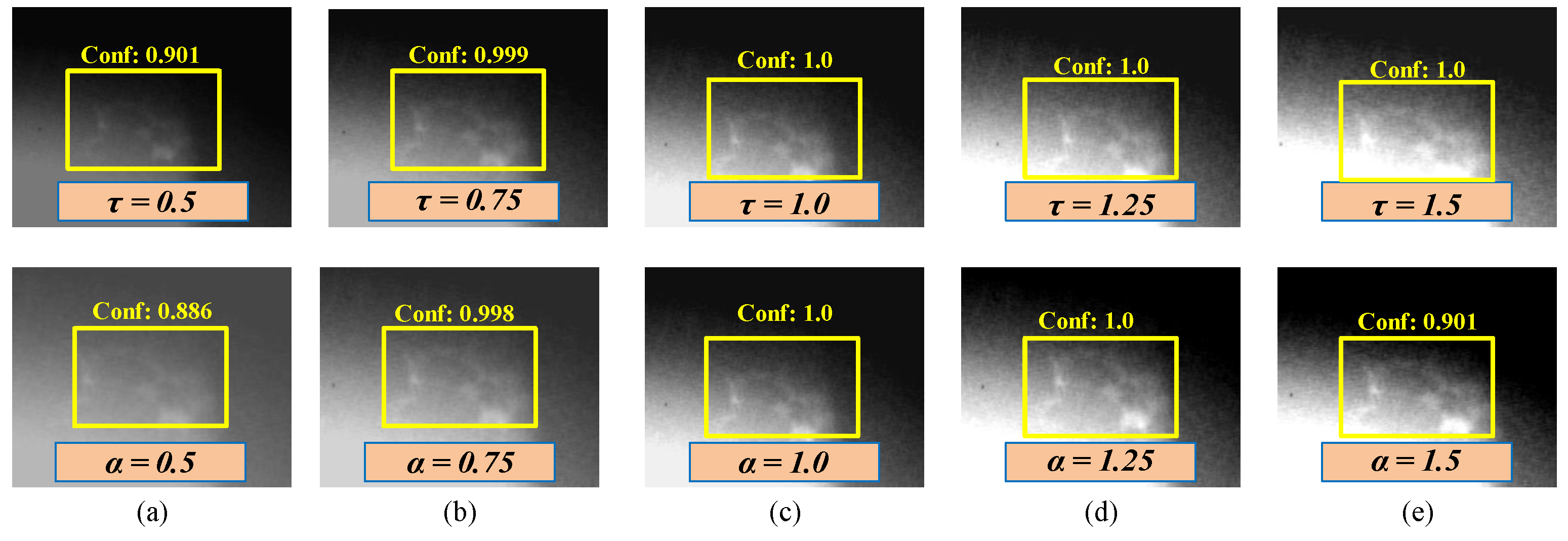
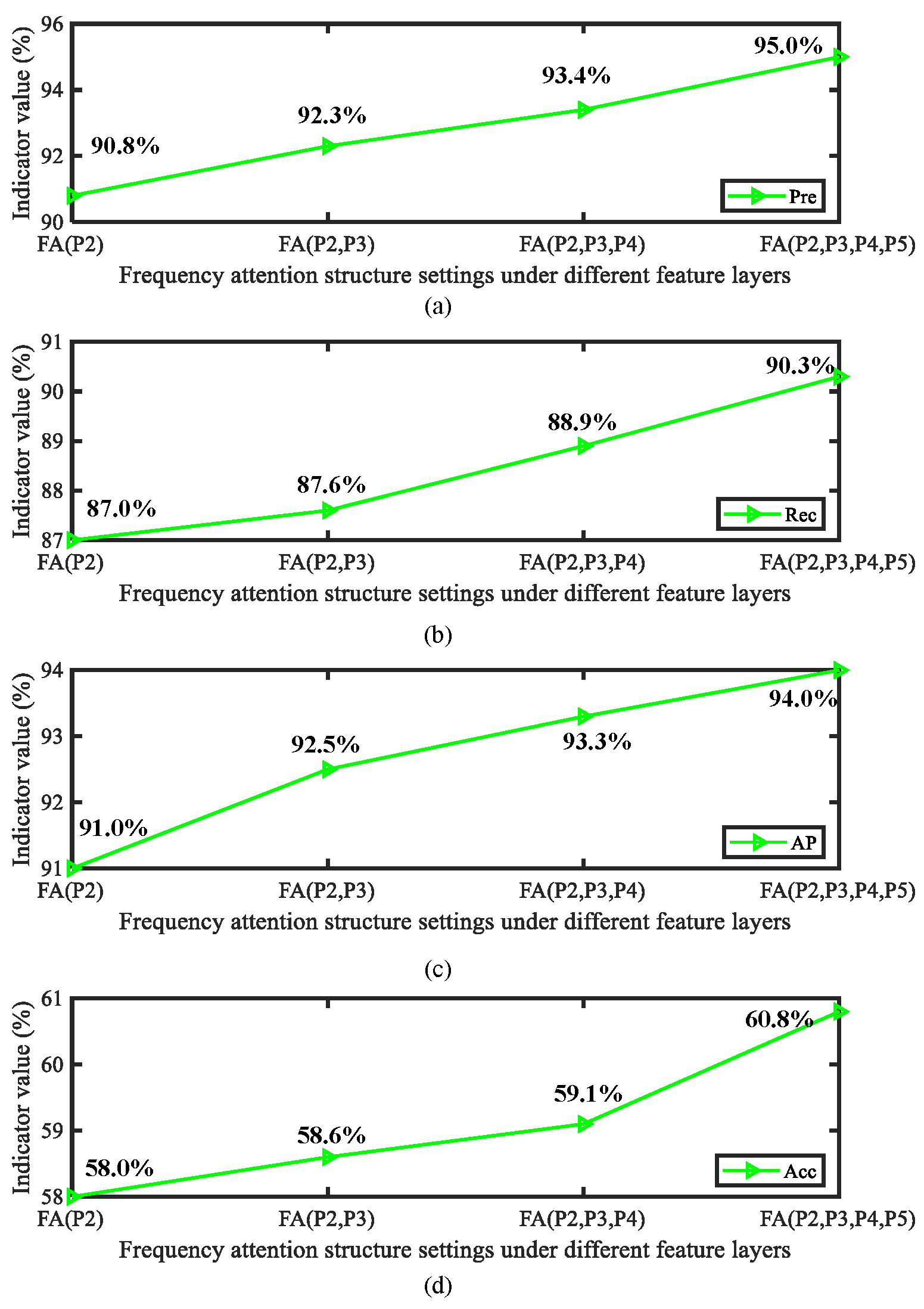

| Stage | Input Size | Layer Parameters | Output Size |
|---|---|---|---|
| + + | (320, 320, 32) | ||
| ++ | (160, 160, 64) | ||
| + | |||
| + + | (80, 80, 128) | ||
| + | |||
| + + | (40, 40, 256) | ||
| + | |||
| + + | (20, 20, 512) | ||
| FDA | PFRM | MDPIoU | Pre | Rec | AP | Acc |
|---|---|---|---|---|---|---|
| 0.826 | 0.821 | 0.863 | 0.550 | |||
| ✔ | 0.836 | 0.835 | 0.883 | 0.579 | ||
| ✔ | ✔ | 0.854 | 0.894 | 0.923 | 0.593 | |
| ✔ | ✔ | 0.903 | 0.889 | 0.936 | 0.599 | |
| ✔ | ✔ | ✔ | 0.950 | 0.903 | 0.940 | 0.608 |
| No. | Pre | Rec | AP | Acc |
|---|---|---|---|---|
| Multi-scale YOLO [20] | 0.848 | 0.871 | 0.889 | 0.564 |
| PADSFPN [21] | 0.867 | 0.869 | 0.895 | 0.593 |
| ADSM [22] | 0.899 | 0.887 | 0.898 | 0.587 |
| Coordinate attention [39] | 0.893 | 0.901 | 0.903 | 0.591 |
| Self-attention [30] | 0.900 | 0.889 | 0.887 | 0.583 |
| DS-Cascade RCNN [23] | 0.906 | 0.887 | 0.904 | 0.598 |
| Proposed | 0.950 | 0.903 | 0.940 | 0.608 |
| Brightness | Pre | Rec | AP | Acc |
|---|---|---|---|---|
| 0.938 | 0.862 | 0.905 | 0.562 | |
| 0.947 | 0.898 | 0.936 | 0.603 | |
| 0.950 | 0.903 | 0.940 | 0.608 | |
| 0.936 | 0.903 | 0.928 | 0.597 | |
| 0.936 | 0.871 | 0.915 | 0.565 |
| Contrast | Pre | Rec | AP | Acc |
|---|---|---|---|---|
| 0.867 | 0.724 | 0.824 | 0.508 | |
| 0.936 | 0.888 | 0.925 | 0.597 | |
| 0.950 | 0.903 | 0.940 | 0.608 | |
| 0.940 | 0.896 | 0.933 | 0.600 | |
| 0.930 | 0.865 | 0.912 | 0.570 |
Disclaimer/Publisher’s Note: The statements, opinions and data contained in all publications are solely those of the individual author(s) and contributor(s) and not of MDPI and/or the editor(s). MDPI and/or the editor(s) disclaim responsibility for any injury to people or property resulting from any ideas, methods, instructions or products referred to in the content. |
© 2024 by the authors. Licensee MDPI, Basel, Switzerland. This article is an open access article distributed under the terms and conditions of the Creative Commons Attribution (CC BY) license (https://creativecommons.org/licenses/by/4.0/).
Share and Cite
Wang, Y.; Zuo, F.; Zhang, S.; Zhao, Z. Progressive Frequency-Guided Depth Model with Adaptive Preprocessing for Casting Defect Detection. Machines 2024, 12, 149. https://doi.org/10.3390/machines12030149
Wang Y, Zuo F, Zhang S, Zhao Z. Progressive Frequency-Guided Depth Model with Adaptive Preprocessing for Casting Defect Detection. Machines. 2024; 12(3):149. https://doi.org/10.3390/machines12030149
Chicago/Turabian StyleWang, Yingbo, Fengyuan Zuo, Shuai Zhang, and Zhen Zhao. 2024. "Progressive Frequency-Guided Depth Model with Adaptive Preprocessing for Casting Defect Detection" Machines 12, no. 3: 149. https://doi.org/10.3390/machines12030149
APA StyleWang, Y., Zuo, F., Zhang, S., & Zhao, Z. (2024). Progressive Frequency-Guided Depth Model with Adaptive Preprocessing for Casting Defect Detection. Machines, 12(3), 149. https://doi.org/10.3390/machines12030149






